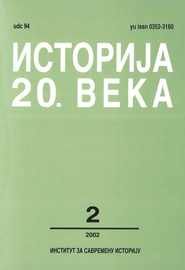ДЕЛОВАЊЕ ЗАЈЕДНИЦЕ ИСЛАМСКИХ ДЕРВИШКИХ РЕДОВА АЛИЈЕ (ЗИДРА) НА КОСОВУ И МЕТОХИЈИ 1974-1991
THE ACTIVITY OF THE COMMUNITY OF DERVISH ORDERS ALIA IN KOSOVO 1974-1991
Author(s): Dragan NovakovićSubject(s): Geography, Regional studies, Political history, Recent History (1900 till today), Islam studies, Post-War period (1950 - 1989), Transformation Period (1990 - 2010), History of Religion
Published by: Institut za savremenu istoriju, Beograd
Keywords: Yugoslavia; Kosovo; Islamic Dervish Orders; activities; 80s; 90s;
Summary/Abstract: The decision on the ban on the activity of dervishes and closing of all tekkiyas in the territory of Bosnia and Herzegovina was passed by the highest bodies of the Islamic community in Yugoslavia in 1952. By coordinated activities of government and Islamic bodies dervishes were gradually marginalised and neutralised in the Republic of Macedonia. The deep roots of Sufism, historic connections of dervishes with part of Albanian population and presence of a number of active tekkiyas, prevented a similar action conducted in Kosovo and Metohija from being successful. Favourable political circumstances arising after the adoption of the Constitution of SFRY in 1974 bolstered the confidence of dervishes and after the initially planned Association, founded an independent, also from the official Islamic community, the Community of Islamic Dervish Orders. Government bodies, primarily because of the negative attitude of the official Islamic community, were against the formation of a new religious community, but measures, at the disposal of the ideological state at the time, were not undertaken to prevent its constituent conference and subsequent operation. In line with political opportunism characteristic of that period, a negative attitude to dervishes and their organisation was taken by certain bodies of socio-political organisations at the time, whose conclusions, in this case, were not mandatory in practice. Instead of expected ban, in 1984 dervishes formed their special Association, adopted a Statute and elected a Presidency. Special activity was not developed, but relations were established with government representatives and a contract concluded for pension and invalidity and health insurance of dervishes. This analysis clearly shows that the competent authorities failed to interpret correctly the reasons because of which the independent dervish organisation had been formed, nor did they understand the essence of tasawwuf and its theological, political and social doctrine. The influence of dervishes on the aggravation of the situation in Kosovo and Metohija should not be underestimated, which will be best illustrated by the fact that their presence was the greatest in the municipalities of Djakovica, Decane, Suva Reka and Prizren, where the numbers of the Serbian population, with the exception of Prizren, were the lowest in the entire Kosovo and Metohija until 1991.
Journal: Istorija 20. veka
- Issue Year: 2002
- Issue No: 2
- Page Range: 103-115
- Page Count: 13
- Language: Serbian

